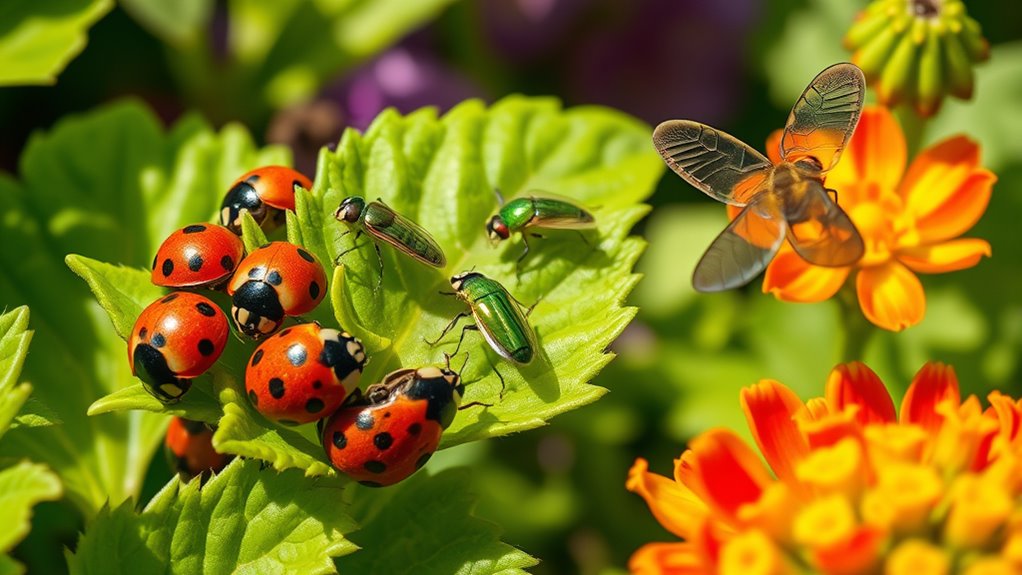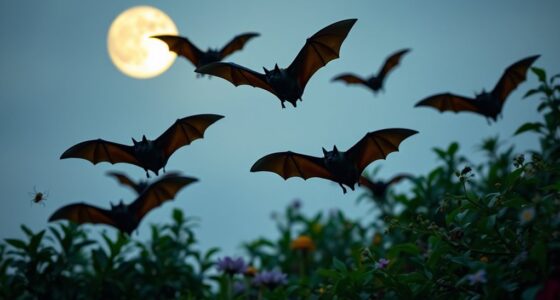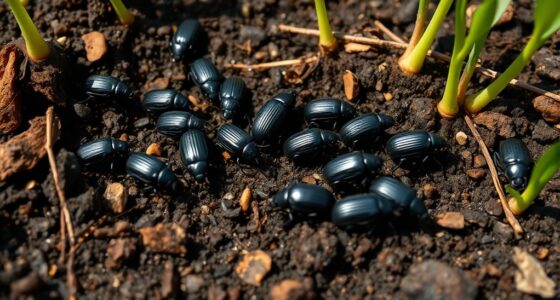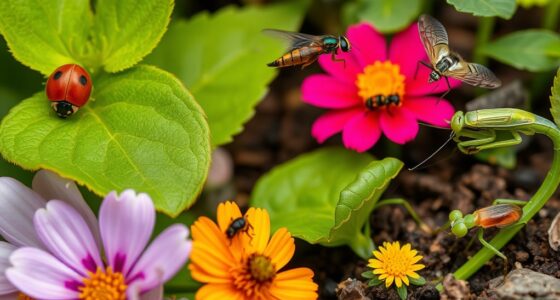To boost your garden’s health, you should know about seven key beneficial insects: ladybugs, which feast on aphids; lacewings that control caterpillars and thrips; hoverflies whose larvae eat small pests; parasitic wasps that target whiteflies and caterpillars; spiders that capture various insects; pollinating bees that boost plant productivity; and predatory beetles that keep pest populations down. Supporting these insects creates a balanced, thriving ecosystem. Keep exploring to discover how to attract and care for these helpful allies.
Key Takeaways
- Ladybugs efficiently control aphids, scale insects, and soft-bodied pests.
- Lacewings larvae prey on caterpillars and thrips, aiding in pest reduction.
- Hoverflies larvae feed on aphids, providing natural pest management.
- Parasitic wasps target pests like whiteflies and caterpillars by laying eggs inside them.
- Supporting diverse flowering plants attracts these beneficial insects, enhancing natural pest control.
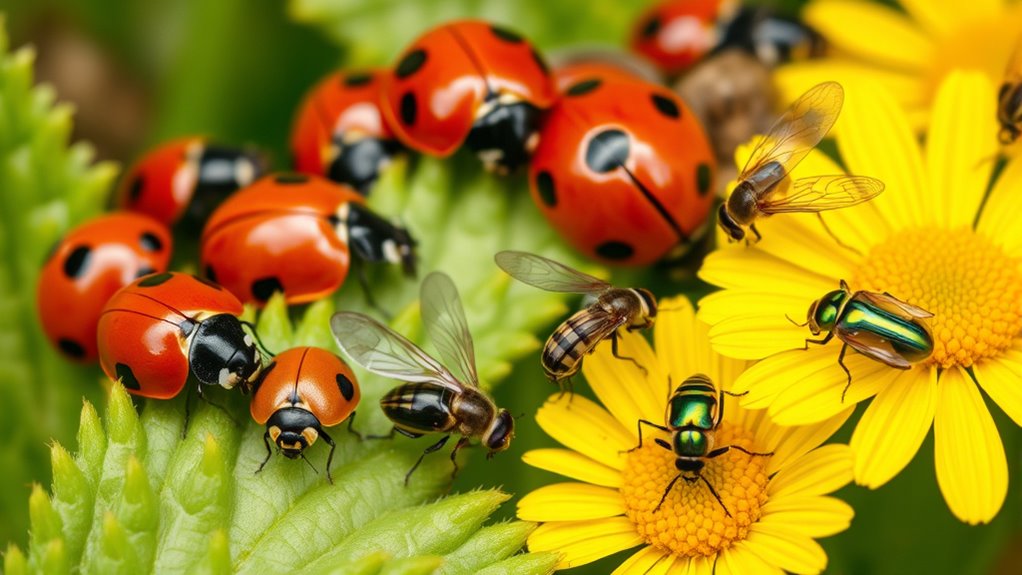
Beneficial insects play a pivotal role in maintaining a healthy garden ecosystem by naturally controlling pests and promoting plant growth. When you understand how these insects work, you can reduce your reliance on chemical pesticides and create a more sustainable environment. Many beneficial insects serve dual purposes—they help manage pest populations through pest control methods and enhance your plants’ productivity via pollination strategies. By attracting and supporting these insects, you can keep your garden thriving without harmful chemicals.
Supporting beneficial insects reduces chemical use and boosts garden health naturally.
For example, ladybugs are among the most popular natural pest controllers. They feast on aphids, scale insects, and other soft-bodied pests that can quickly damage your plants. Introducing or encouraging ladybugs in your garden can considerably reduce pest outbreaks, making pest control methods more effective and eco-friendly. Similarly, lacewings are advantageous because their larvae prey on a variety of pests, including caterpillars and thrips. You can attract lacewings by planting flowering plants like dill, fennel, or yarrow, which serve as nectar sources.
Hoverflies are another key player in natural pest control. Their larvae feed on aphids and other small pests, while adult hoverflies are attracted to flowers, aiding in pollination strategies. By planting a diverse range of flowering plants, you create a habitat that attracts these beneficial insects, combining pest control with pollination support. Bees, especially native solitary bees, are essential pollinators that boost fruit and vegetable yields. Providing bee-friendly plants and avoiding pesticides ensures these insects can thrive and contribute to your garden’s productivity.
Parasitic wasps also offer a natural pest control method by laying eggs inside pests like caterpillars and whiteflies. As their larvae develop, they kill the host pests from within, keeping pest populations in check without harming your plants. To support these wasps, plant a variety of flowering plants that bloom throughout the season, providing continuous nectar sources. This approach aligns with integrated pest management strategies, making pest control more effective and less reliant on chemical solutions.
Understanding and utilizing these beneficial insects empower you to adopt more sustainable gardening practices. By fostering environments that attract and sustain natural predators and pollinators, you create a balanced ecosystem that naturally manages pests and promotes healthy plant growth. Incorporate diverse flowering plants, avoid broad-spectrum pesticides, and be patient—your garden will become a thriving habitat for beneficial insects, ensuring it remains healthy and productive year-round.
Frequently Asked Questions
How Can I Attract Beneficial Insects Naturally?
To attract beneficial insects naturally, you should create a welcoming environment in your garden. Focus on providing a natural habitat by leaving some areas undisturbed and adding native plants. Plant a diversity of flowers and plants to offer nectar and pollen throughout the season. Avoid pesticides, and include features like mulch or water sources. These steps encourage beneficial insects to stay, helping your garden thrive naturally.
Are There Any Risks to Introducing Beneficial Insects?
Did you know that improper use of beneficial insects can sometimes cause pesticide interactions? While they usually help your garden, introducing them without understanding their insect habitat requirements may disrupt the ecosystem. You could unintentionally harm native species or reduce their effectiveness. Always research specific beneficial insects, avoid pesticides, and guarantee their environment supports their needs to minimize risks and promote a healthy, balanced garden.
How Do I Differentiate Beneficial Insects From Pests?
To differentiate beneficial insects from pests, start with pest identification by observing insect behavior. Beneficial insects usually move slowly, focus on specific pests, and rarely damage plants. Pests often damage leaves, stems, or fruits, and may exhibit aggressive or destructive behavior. Learning these signs helps you identify beneficial insects accurately, ensuring you promote natural pest control without harming your garden’s ecosystem. Recognizing these differences keeps your garden healthy and thriving.
When Is the Best Time to Release Beneficial Insects?
Think of releasing beneficial insects as planting seeds of harmony; timing is everything. The best time to release them aligns with seasonal timing, typically early in the pest invasion or when pest activity peaks. Use strategic release strategies by monitoring pest levels and weather conditions. This proactive approach guarantees beneficial insects thrive and keep your garden balanced, turning nature’s chaos into a well-orchestrated symphony of growth and health.
Can Beneficial Insects Help With Organic Pest Control?
Yes, beneficial insects can help with organic pest control by naturally managing pests without chemicals. They form pollination partnerships that boost plant health and productivity. By preserving their habitat, you guarantee a thriving environment for these helpful bugs, which keep pest populations in check. This sustainable approach reduces your reliance on pesticides, promotes healthy ecosystems, and supports a balanced garden where beneficial insects and plants coexist harmoniously.
Conclusion
By welcoming these beneficial insects into your garden, you’re like a savvy captain steering your ship through a sea of pests. I once watched a gardener release ladybugs, and within days, their aphid problem vanished—like magic. Just as a healthy ecosystem thrives on balance, your garden benefits from the natural teamwork of these insects. Embrace them, and you’ll nurture a vibrant, pest-free oasis that flourishes with minimal effort.
